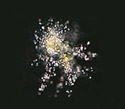Freshwater ponds provide a home for a wide variety of aquatic and semi-aquatic plants, insects, and animals. The vast majority of pond inhabitants, however, are invisible until viewed under the microscope. Beneath the placid surface of any pond is a microscopic metropolis bustling with activity as tiny bizarre organisms pursue their lives; locomoting, eating, trying not to be eaten, excreting, and reproducing. In this collection of digital videos, observe the activities of microscopic organisms taken from a typical North Florida pond.
Protozoans
These one-celled organisms belong to the Kingdom Protista, which includes algae and lower fungi. Although most species of protozoans are invisible to the naked eye, they dominate the Earth's environment, occurring everywhere and in an amazing diversity of forms and functions.

Amoeba
Amoebas are organisms characterized by their flowing movements, extending cytoplasm outward to form pseudopodia; this type of movement is considered to be the most primitive form of animal locomotion.

Euglena rostrifera
This species is a member of the protozoan order Euglenida, a remarkable group of single-celled creatures, many of which exhibit characteristics of both plants and animals.
Tardigrades
Approximately 350 species of the phylum Tardigrada (slow-walking animals) are known to occur worldwide. Also called water bears, most of these free-living organisms are one millimeter or less in size and live in a wide variety of habitats: in damp moss, on flowering plants, in sand, in freshwater, and in the sea.

Echiniscus
This genus of water bear is widespread and common. Their bodies are short, plump, and contain pairs of poorly articulated limbs. They lumber about in a slow bear-like gait over grains of sand, dirt or vegetation.